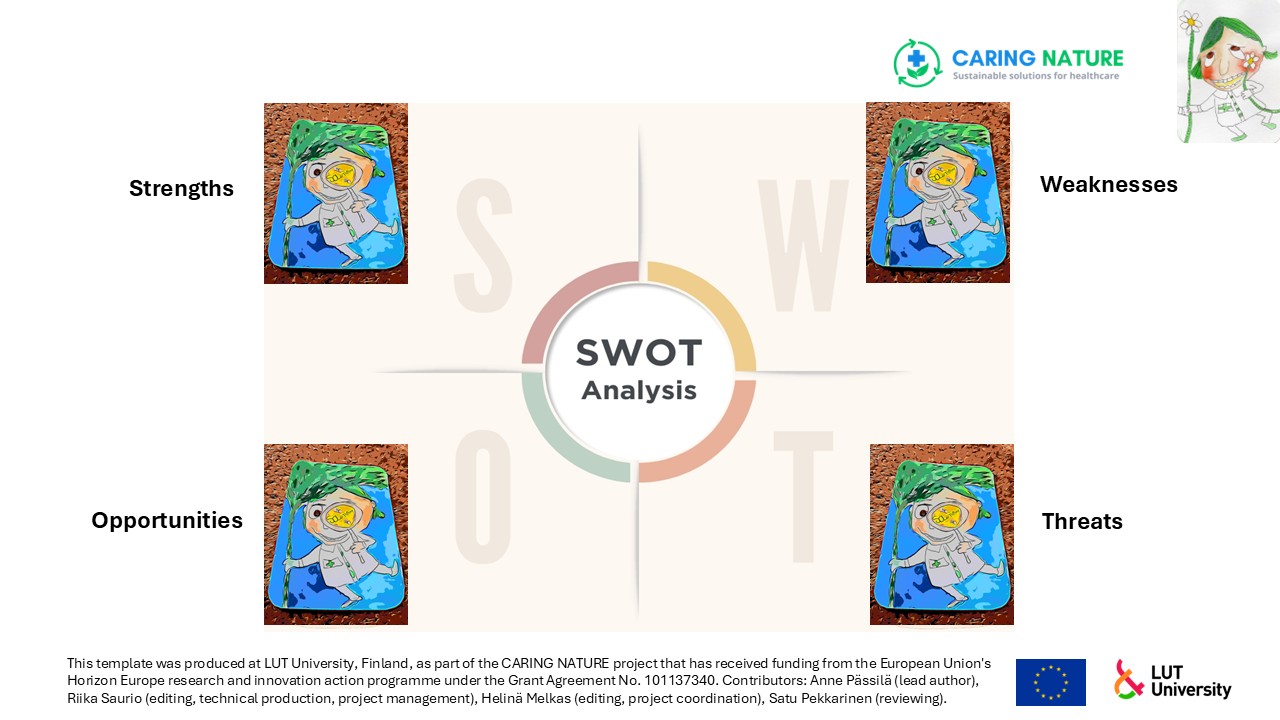SWOT ANALYSIS OF THE GREEN TRANSITION
Paradigm-preserving methods
SWOT analysis is one of the best-known and most widely used strategy and decision-making tools. It is based on an assessment of an organisation's or individual's internal Strengths, Weaknesses, Opportunities and Threats.
In the context of the green transition, the SWOT analysis helps to provide a holistic view of the environment and the health and care organisation and to outline the direction in which development should be steered.
What is required:
- The group's focus and willingness to make honest assessments of the current state of the organisation or project.
- Time for reflection and discussion to bring out different perspectives.
- Openness and trust, so that weaknesses and threats can be addressed constructively.
Level of difficulty: 1-2 (simple and straightforward, but an in-depth analysis takes time and diligence)
Time required: 30-90 minutes, depending on the size of the group and the depth of the analysis.
Materials:
- Paper or a flipchart
- Writing tools
- A table with the four SWOT categories
Participants: A minimum of 2 people, but a group of 4-6 people can achieve the best results. Group members can be from inside or outside the organisation, depending on needs.
How to use:
- Getting started: assemble the team and define precisely what you want to analyse (for example, a project situation, organisational strategy, service, etc.).
- Completing the SWOT table:
- Fill in the four sections: Strengths, Weaknesses, Opportunities, Threats.
- Discuss and highlight important factors in each category.
- Analysis: go through all the sections and consider how to build on strengths, improve weaknesses, pursue opportunities and minimise threats.
- Decisions and actions: define the following steps to be taken based on the results of the SWOT analysis.
When to use:
- Can be used for green transition related strategy planning, environmental project planning, organisational sustainability planning or evaluation.
- Well suited for working with teams and individuals.
Why to use:
- A SWOT analysis of the green transition helps to give an overview of the current situation.
- Encourages group members to consider both internal and external factors, allowing for deeper reflection and the development of a more comprehensive strategy for the green transition.
- Strengthens common understanding and clarifies decision-making on the green transition.
How to document:
- The table can be captured as a photo.
- As notes with the results of the SWOT analysis of the green transition and the reflections of the group members.
- Documentation of jointly agreed actions and responsibilities that emerge from the analysis.
The roots of the method can be found here: The SWOT analysis is a traditional strategic tool originally developed in the 1960s by Albert Humphrey. It is based on classical business analysis models but has since been extended for use at all organisational levels and in different contexts. Theories related to SWOT are based, among others, on strategy development (Porter, 1985) and analysis of the business environment.
